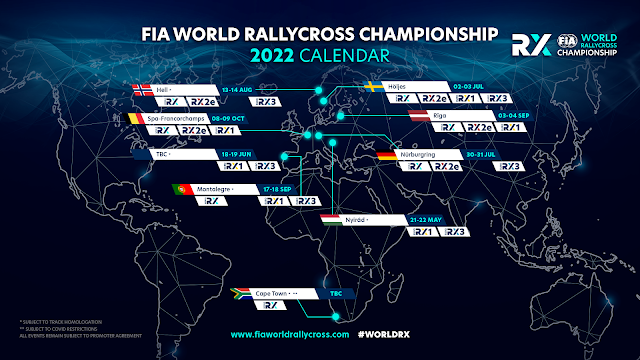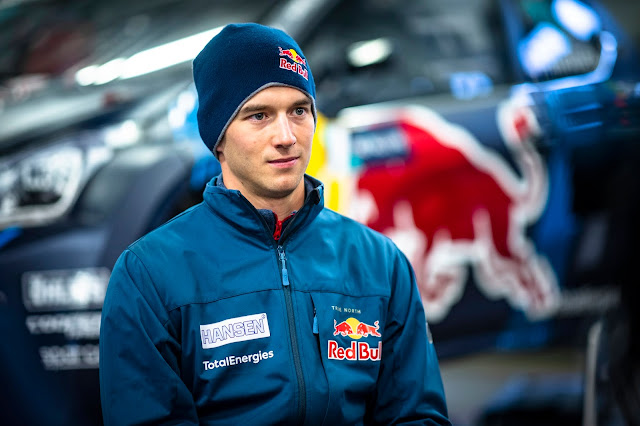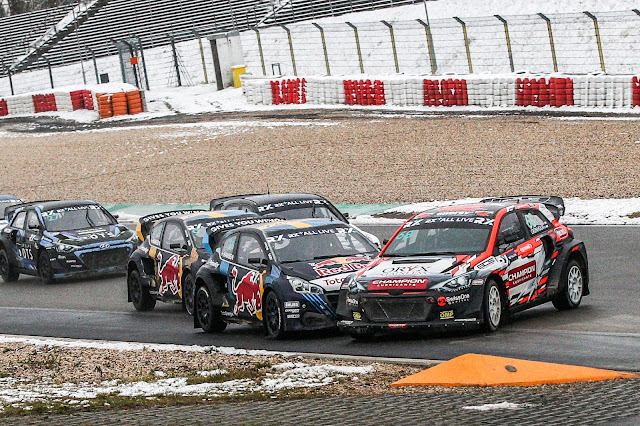Through the years, the motor racing spectacle has not only entertained but captured the imagination of fans, and future stars. In recent years more disciplines have joined the likes of Extreme E, MotoE, Nitro Rallycross, etc. but one thing they all have in common is a defined course, a track or route.
Circuits are designed per discipline, which means, the likes of MotoGP, Formula 1, WTCR, WEC, etc. would share the same venue, whilst Rallycross, Extreme E, Dakar, Motocross all have their own specific designed tracks.
If you were to focus on Formula 1, the pinnacle of motorsport has many of it’s newer circuits designed by Hermann Tilke. Whilst the more historic circuits like Silverstone, the Hungaroring or Spa-Francorchamps were not designed by Tilke.
Tilke designed circuits have a bit more run-off zones allowing for more disciplines to use them.
Other motorport championships such as, Extreme E have their own method of designing a course/track. The newly formed championship (Extreme E) has two contracted “championship drivers”, Timo Scheider and Tamara Molinaro who design the course for the each event. Whilst the Dakar Rally shares similar characteristics being an off-road event, but the concept of route design is completely different, because a team would go into the Saudi Arabian desert to plot the layout for the two week event.
So, with those differences explained, the FIA World Rallycross Championship is slightly different, as its a duel-surfance discipline meaning tarmac and dirt makes up the track.
As, we know rallycross has a rich 54-year history with some of the most historic venues that capture that imagination of drivers’ and fans alike, a perfect example is the hill side, Hell track in Norway.
But, why Norway? Well! The Scandinavian countries eat, sleep and breathe rallycross, with their most successful rallycross driver of all-time, Kenneth Hansen, (14-time European Rallycross Champion) hailing from Sweden.
Petter Solberg, is another legend from Scandinavia. A two-time FIA World Rallycross, whilst his former team-mate Johan Kristoffersson, the most successful driver in the FIA championship having won four-titles to date.
Scandinavia has some of the most historic rallycross circuits, the likes of Holjes, Hell and Arvika to name a few, but do they really comply with the FIA regulations? Some may not at first but in order to host an FIA regulated event changes need to be made. They could either be safety related or just small tweaks.
 |
The World RX of Germany (Nurburgring) track layout overlay on existing circuit.
PHOTO CREDIT: World Rallycross of Germany. |
So, what are the regulations set out by the FIA Off-Road commission for track design(s)? Let’s take a look below:CHAPTER 3. RALLYCROSS CIRCUITS
1. Characteristics
Length (measured along the centre-line of the
course) : minimum: 950m; maximum: 1400m.
Width: minimum: 10m; maximum: 25 m
2. Composition
Sealed surface (asphalt, concrete, etc.): between 35 % and 60 %.
The remainder unsurfaced (consolidated /stabilised earth or gravel). In addition to watering, anti-dust treatment is obligatory.
3. Gradients
Must not be steeper than 10 %.
4. Starts
There must be at least 100 m of straight from the starting line to the first bend. The starting grid will have a uniform surface of asphalt, tarmac, or concrete, this to continue for at least 30 metres after the starting line. The width of the track at the start line (minimum 14.50 metres) will be maintained up to and through the first bend, which must have a maximum radius of 25 metres and result in a change of direction of at least 45°; measurements will be calculated from the centreline of the course.
5. Marking
Should there be a deviation in the course (e.g. an artificial chicane included to reduce speeds), this must be marked in an obvious and entirely unmistakable way.
6. Joker lap
Characteristics:
Length: must be such that the time needed to cover a lap is at least 2 seconds longer than the best lap time achieved in Division 1. at least 2 sec longer than the time needed for the replaced distance of the circuit.
Width: minimum 10 m, maximum 12 m.
The entry and the exit cannot be on the racing line.
A safety protection, to separate the two roads, must be in place. At the exit it must be possible for the cars to have the same speed as on the traditional circuit.
A marshals’ post will be put in place if judged necessary for safety reasons.
An Approval by of the FIA circuit safety inspector is required.
With a more clearer idea of how circuits should be designed for the FIA World Rallycross Championship, there are a number of other factors and elements that need to be taken into account.
So, in order to get a better understanding of this, we chat to the World RX Championship coordinator, Tim Whittington who will give us a bit more insight into track design. We also delve into a bit more detail regarding the switch to the electric championship this year.
After a six-year stint as promoters of the championship, IMG stepped aside paving the way for Rallycross Promoter GmbH, who immediately made changes with new broadcasting portals, etc, but one of there biggest tasks would be managing the switch to electric power in 2022.
So, what involvement does Rallycross Promoter GmbH have when it comes to circuit design?
Tim Whittington: “The Promoter is almost always involved. It’s generally a question of sharing information and knowledge, trying to ensure that every new track is as good as it can be. (For detail, the Off-Road Commission does not approve circuits, this is the Circuits Commission and the Circuits/Safety dept at FIA).”
World Championship status means championships can travel to all corners of the globe, a scene last seen in 2017 when the FIA World Rallycross Championship traveled to all corners of the globe from the USA, to Africa and Europe.
 |
2017 World Rallycross of Cape Town with Table Mountain in the backdrop.
PHOTO CREDIT: FIA World Rallycross Media/Jaanus Ree |
How are new tracks designed? Is it based on facilities at hand or solely around the FIA regulations? Or is there a free reign element when it comes to designing a track for the world championship?Whittington: “This really depends on the venue and varies quite a lot. Let’s take Cape Town as the example here, but many points are relevant to all new circuits. We need to achieve a track that meets the FIA regulations and which fits within the existing venue. It needs to be in a part of the venue that is good for spectators on-site and is going to create a good TV image. In Cape Town that very quickly became the T2, T3, T4 section of the Killarney circuit. It offered the space required, areas of infield that could accommodate the unsealed sections that would need to be added and gave the backdrop of Table Mountain so there was an immediate and obvious visual connection to the location.”
“Once those basic decisions had been made it was a question of designing a track that met the regulatory requirements, that was safe, which did not unnecessarily disrupt other activities at what is a busy race circuit and which could be built within a budget that allowed a viable business case for all parties involved.”
With an action-packed championship like World RX. Why are most of the circuits designed quite tightly? Meaning there is only one racing line, and once you're following it's difficult to make a pass or overtake.
Can racing be improved by altering track design to allow more door-to-door racing in the future?
TW: “Rallycross Promoter is working with circuits, drivers and others to define how existing circuits can be changed to improve racing and how future newbuilds should be designed to encourage passing. We want circuits that provide great racing, encourage more passing and challenge the drivers.”
“Rallycross tracks are quite short, FIA regulations say between 800 and 1400m, circuits have generally been in this kind of range. Many of the traditional tracks in Europe date from the 1970s and 80s. Cars were smaller and technically less sophisticated then so there was more space on the track and because the cars were not as good, more difficult to drive, the drivers made mistakes more often. All of that made passing easier. The modern cars are outrageously good and, compared to cars from previous generations, easier to drive, so mistakes are much less frequent and drivers have more time to think about racecraft where in the past just keeping the car on the circuit was as much as many could do. We want to make the tracks more challenging to redress that balance.”
Many championships have their own historic tracks, Lydden Hill (UK) or Holjes (Sweden) for example. Each have their own rich history, so are any changes made to cater to the FIA championship? And, if so what changes are or can be made to them?
TW: “We want the racing to be better and are working with the existing venues to make changes.”
With a better understanding of circuit design and an understanding of how the championship aims to improve racing. The World RX championship has a number of high and low grip tracks. Are these characteristics decided by venue or championship promoters?
TW: “The greatest difference in the circuits is the degree to which the unsealed surfaces have been stabilised. In most of the environments in which we race some form of stabilisation is necessary. It is also required by the current FIA regulations. We have tracks like Riga and the traditional French tracks which are heavily stabilised. There are also circuits which have a lower degree of stabilisation such as Montalegre or Estering. Many factors can influence the degree of stabilisation; materials available, cost of construction and ongoing maintenance, how the rallycross track fits within other activities at the venue, etc. The mix of surface types is important because it gives the different circuits their own identity and each presents its own challenge. The mix could probably be shifted to include more circuits with lower levels of stabilisation where we have the opportunity to do that.”
Curve ball time, which track on the current calendar presents the best action, and why?
TW: “I think all of the tracks have their good points and can offer some good racing even if none of them represent the ‘best possible’ rallycross track at the moment.”
I guess he’s going to keep quiet on that one.
In the Americas, the Red Bull Global Rallycross Championship (GRC) was the very first rallycross championship, but it, unfortunately folded in 2018, which paving the way for the previous World RX rights holders IMG, to start an American based series, Americas Rallycross (ARX) it also folded after two-years.
 |
2019 World Champion Timmy Hansen's ideal rallycross track layout.
|
In 2018, Rallycross joined the Nitro World Games and instantly made waves due to the "extreme" nature of the circuit designs and the close action-packed racing. World RX driver Timmy Hansen won the inaugural event.
A few years later, Travis Pastrana announced the Nitro Rallycross Championship, which would see teams race at five unique circuits designed by himself. It went off without a hitch and produced some thrilling action.
In 2019, we spoke to a number of World Rallycross drivers, and asked them to draw their ideal circuits. A number of them designed Nitro RX themed circuits with jumps and high banked corners. So, could we soon see similar Nitro Rallycross concepts in the FIA World Rallycross Championship calendar?
TW: “There are elements of the Nitro tracks which could be used within an FIA World Championship circuit, but also some that I do not think FIA would approve.”
The 2021 FIA World Rallycross Championship was the final season of internal combustion engines. So, with the move to electric power this year. Can fans expect to see circuit modifications to spice up racing?
TW: “We are working to introduce changes to circuits for the 2022 season, but that is not directly influenced by the switch to electric cars, and the new cars in themselves do not require changes.”
“A factor of the change of car that is likely to play a part in improving racing is that all cars will use the same powertrain kit, and so the differences between the cars will be reduced. Performance should be more even and racing closer.”
Having now learnt a bit more about track design, and what is allowed according to the regulations. We look forward to a thrilling new era in 2022. The championship will visit seven countries, including South Africa (tbc), with seven confirmed entries across four teams. Are you ready? Let’s go racing!
We would like to thank Tim Whittington, the FIA World Rallycross Championship co-ordinator for taking the time out of his very busy schedule to talk to us!

























